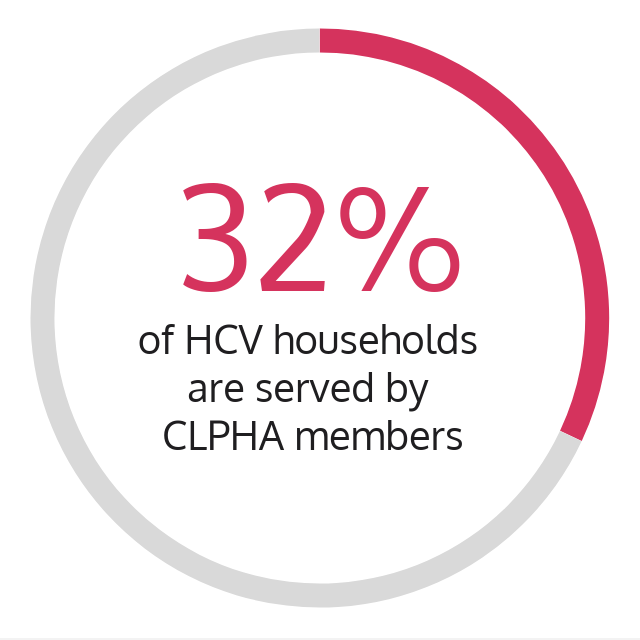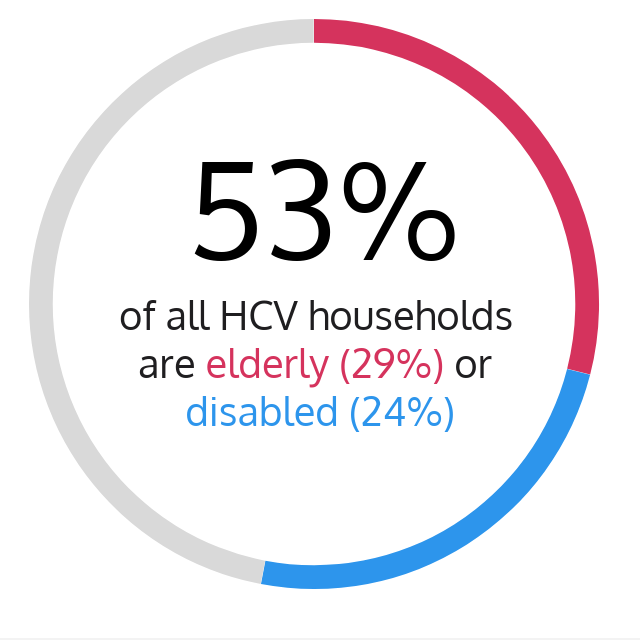


The HCV program supports the lowest-income families who struggle to secure safe, affordable housing in the private market. At least 75 percent of new voucher holders must have incomes that are below 30% of their area’s median income. In 2018, the average annual household income among tenants in the program is approximately $14,700.
While targeting the most economically disadvantaged households, the HCV program also serves the most vulnerable. In 2018, 53 percent of HCV households were elderly (29 percent) or disabled (24 percent). Forty percent of HCV households included children under the age of 18. Of those non-disabled, non-elderly HCV households, 75 percent were working, worked recently, or likely were subject to work requirements.
HUD has published the final rule implementing changes to the HCV and PBV programs made by the Housing Opportunity Through Modernization Act of 2016 (HOTMA). CLPHA’s full analysis of the entire final rule is still in-progress; however, we have prepared an interim analysis of key provisions related to Project-Based Vouchers (PBVs).
The general program cap for PBVs that limits the number of units to 20% of the authorized units remains (24 CFR 983.6). In certain instances, there is an exemption where units may be project-based up to 30% (983.6(d)). Units meeting this exemption include:
- units for people experiencing homelessness (983.6(d)(1)(i));
- units for veterans (983.6(d)(1)(ii));
- units providing supportive services for people with disabilities or elderly people (983.6(d)(1)(iii));
- units in areas where vouchers are difficult to use (983.6(d)(1)(iv));
- units that replace units that had previous rental assistance, but are now on a different site (983.6(d)(1)(v)); and
- units for certain eligible youth in the FUP program (983.6(d)(2)).
Further, certain units are excepted & the PBV portfolio cap does not apply to them (983.6(e)). To be excepted, these units must in the previous five years before a PBV RFP have received certain federal assistance (& they should no longer be receiving that assistance). A list of the types of assistance that had to have received assistance can be found at 983.59(b). The new units on that list that the rule allows include:
- former LIHTC units (983.59(b)(2)(i));
- former USDA Section 515 units (983.59(b)(2)(ii));
- and other units selected by HUD though the Federal Register (983.59(b)(2)(iv)).
When you add up these different types of PBV units (regular PBV units (20%) + exempted PBV units (another 10%) + excepted PBV units (no limit)), it is theoretically possible to project-base more than 50%. Because of this, if you are project-basing more than 50%, before additional project-basing, you will have to do an analysis of project-basing 50% or more of your ACC units. 983.58(b). Keeping this in mind, you can project-base varying amounts depending on whether you can fit those units into the categories listed above.
CLPHA is still analyzing the lengthy rule and will publish a full analysis of all HCV and PBV provisions as soon as possible.
PBV Options
To compare the old and new PBV regulations, CLPHA and Reno & Cavanaugh have produced a helpful PBV Options comparisons chart. Historically, the PBV regulation identifies two categories of housing that could receive PBV – “existing housing” and “Rehabilitated and Newly constructed Units. (“Rehab/New”). The upfront review requirements for existing housing are much lower than for Rehab/New. Once a project is selected for PBV, no material work can be done on the units unless the project receives preclosing approvals related to Rehab/New Construction in Subpart D of the regulation.
The new regulations (“New Reg”) overhaul offers more options, but on a delayed basis as HUD needs to issue new forms. The upfront requirements for Rehab/New housing stay in place despite new flexibility. All options except #1 and #3 must also be in the PHA’s Admin Plan before a PHA can use them.
1.Rehabilitated and Newly constructed Units (Rehab/New)
a.983.154 (a) through (d)
b.Obtain SLR and ER approvals, execute AHAP and do Work. When the Work is done, inspect units, and execute HAP (in one or multiple stages) as units are leased up.
c. Pros: regulatorily neatest. No change from current proactive
d. Cons: SLR may take several months. Project will not begin earning income or housing tenants until after SLR approval and then Work are completed.
2.Variation #1 – “Development Agreement” instead of AHAP, then execute HAP
a.983.154(f)
b.As in #1, all rehab/new requirements mut be met before Work can start.
c. Pros: Could cover business issues that AHAP does not
d. Cons:
i. Implementation delayed until HUD issues a form document
ii. HUD would likely review during management review or audit
3.New Definition Existing Housing
a. Units “substantially meet HQS” at selection, which means
i. Repair and replacement with same quality (not improvement) AND
ii. Work can reasonably be done within a 30-day period.
b. Units not reasonably required to require Substantial Improvement within 2 years (see chart for definition)
c. All units must meet HQS before HAP is executed
4.Rehabilitated Housing –Doing Substantial Improvements while HAP in Place
a. Type 1: Execute Existing Housing HAP, Do improvements/rehab in 2+ years.
i. 953.154(6); 983.157
ii. Do portion of Work that is not Substantial Improvement under the New Reg. (see chart). After two years, execute Rider and do Work.
iii. Pros:
1. Project begins producing income and housing tenants immediately. No delays, cost, or hassle due to SLR.
iv. Cons:
1. Implementation delayed until HUD issues a form Substantial Improvements Rider that permits work on PBV Units under HAP.
b.. Type 2: Execute Existing Housing HAP for only the units not requiring Substantial Improvements.
i. 983.157; 983.207(d)
ii. When HUD issues Substantial Improvements Rider, arrange to do Work on the units not covered by the HAP. Note that the non-PBV units could still be leased to HCV holders during this period.
iii. Pros: Project begins producing income and housing tenants immediately.
iv. Cons: Same “rehabilitated housing” limitations as Option 2. See Exhibit B for regulation excerpts related to this idea.
CLPHA will publish a long-format analysis of the entire rule as soon as possible. If you have any questions, email [email protected].
HUD Revising HIP Implementation Schedule Now
This morning, HUD sent an email to notify PHAs that the schedule published in the HIP Implementation Notice will be revised in the coming weeks as HUD is not ready for the transition and critical dates will be extended. Recently, PHA software vendors encountered technical issues in the initial testing phase of the 2020 version of the HUD-50058 forms. HUD will resolve these issues before transitioning to HIP.
HUD is also discussing the feasibility of delaying the compliance date for Sections 102 and 104 of HOTMA in part to allow for HOTMA-compliant 2024 versions of the 50058 forms to be developed in HIP. These sections were implemented through the final rule “Housing Opportunity Through Modernization Act of 2016: Implementation of Sections 102, 103, and 104” (88 FR 9600). As a reminder, under the current requirements in Notice H2023-10/PIH 2023-27, PHAs must set a compliance date no later than January 1, 2025.
HUD is working to revise the HIP implementation schedule, and HUD will share the revised schedule with PHAs and PHA software vendors when ready. Once HUD has discussed and incorporated PHA software vendors’ feedback, HUD will reach out to us with updated guidance and the newly revised schedule.
Actions PHAs Should Continue
In the meantime, as outlined in the HIP Implementation Notice, you should continue to review your tenant data in IMS/PIC and make any necessary corrections to support a smooth transition to HIP. PHAs should also continue submitting HUD-50058 forms and any necessary inventory data as they normally would. Also, PHAs that operate Public Housing programs must review their Building and Unit data in IMS/PIC, make any updates, and submit their Building and Unit data for approval in IMS/PIC. A job aid with instructions is available on the IMS/PIC Job Aids page.
Suspended SAC Submission Deadline
The July 1, 2024, deadline for submitting demolition/disposition applications to the Special Applications Center (SAC) will also be extended. You no longer need to submit demolition/disposition applications by July 1. We will issue additional guidance for the new deadline after HUD revises the delivery schedule for HIP.
Feedback Critical to Delayed Implementation
HUD acknowledged in the email that they have heard our feedback: “many PHAs and industry groups requested to delay the HIP implementation citing lack of readiness on the part of the PHAs, their software vendors, and HUD.” This speaks to the critical importance of the IT Working Group that CLPHA convened to facilitate collaboration between HUD, PHAs, and industry software vendors. CLPHA plans to host the next meeting of the IT Working Group soon to further discuss these plans.
The compliance date for NSPIRE-V has been delayed by one additional year until October 1, 2025. The announcement was sent to PHA executive directors today by Principal Deputy Assistant Secretary Richard J. Monocchio.
The original NSPIRE-V notice will soon be re-issued with updated information in light of the extension. HUD published the original NSPIRE HCV Administrative Procedures notice on September 29, 2023. PHAs should also watch for an announcement in the Federal Register once the HCV extension is final.
PHAs that have existing approvals for acceptability criteria variations will still need these approvals reviewed by HUD, but this deadline is extended to before October 1, 2025. All current acceptability criteria variations and alternate inspection methods can remain in place until HUD completes the review unless they included approval of fuel-burning space heaters. Approval of their use as a variation concluded on January 1, 2024. PHAs with questions on variations can email [email protected].
Soon, HUD will update the NSPIRE Smoke Alarm standard to implement the requirements enacted in the Consolidated Appropriations Act, 2023, for either hard wired or sealed, 10-year batteries smoke alarms. PHAs will be required to be in compliance with this new standard before December 23, 2024, even if they are still under the previously defined HQS standard.
The Visual Assessment Standard for Potential Lead-Based Paint Hazards still applies, as NSPIRE did not revise the existing requirements under 24 CFR Part 35 Subparts M (Tenant-based Rental Assistance) and H (Project-based Assistance).
PHAs should also note that the NSPIRE Standard for Carbon Monoxide Alarms will still apply during this extension, because it implements Congressional requirements already in effect.
CLPHA will keep its members up-to-date on NSPIRE-V as soon as the updated Notice and Federal Register announcements are published.